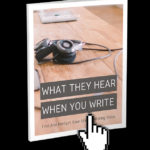Voice is one of the most talked about yet most elusive parts of effective writing. You get an impression or feeling from a piece of content, but it’s not always easy to tell why.
It’s a lot like your handwriting. If 5 members of your family wrote out identical grocery lists, my bet is you’d be able to match them pretty quickly. But if I asked you what about the list revealed the writer, you’d have a hard time pinpointing specific unique strokes or letter formations.
That’s not to say your handwriting doesn’t vary in different situations (don’t look at my notebook, please!), but even when you try to write neatly, subtle idiosyncrasies like the way you make your e’s will give you away to anyone that knows you (even if they don’t know why).
In a business, it’s important to have consistent voice throughout all of your communications. Invisible shifts in your voice are off-putting to your customers. They won’t be able to pinpoint it, something about you will feel inauthentic — which we all know means less trust… and less sales.
Over the next few weeks, we’re going to talk a lot about voice, starting with a 3-part series on the topic. Today will be part 1, What is Voice? We’ll dig into the elements that make up your voice, and the 7 types of voice you’ll see.
Then, stay tuned for Part 2: How to learn someone else’s voice (and why you would want to) and Part 3: How to learn your own voice.
Let’s get started.
Part 1: What is Voice?
“I know it when I see it”
Have you ever read an article and thought… “that sounds like [insert author here]” or “this guy reminds me of [insert someone you know]”?
At the same time, have you ever received a customer service e-mail and could feel it was a form letter and not written by the person you emailed?
This is voice. It’s difficult to identify but you “feel it” when it’s off. The purpose of today’s post is to break down where those feelings come from and what makes a voice.
What makes a voice?
Voice is made up of three main components
- Tone
- Cadence
- Vocabulary
Tone
Tone is easy to understand and easy to recognize. You can usually find the tone by asking two questions: “how is the author feeling?” and “what is the author’s personality?” Answers include: frustrated, sarcastic, aggressive, empathetic, sad, impertinent, flippant, or joyful… among many, many others. Tone gives you the emotional backdrop to the voice. Tone can stay consistent through the piece or change depending on the subject or the character development.
Tone in writing is just like tone in speaking, but often more difficult to convey. We’ve all had those moments where we send a sarcastic text message that was lost in translation and misinterpreted by the receiver. It’s also easy to let your own emotions accidentally affect tone — like when we reply to a boss or a client that is irritating us that day. While our words may be professional, our tone can often cause problems.
It’s difficult to recognize tone in our own work because we are reading the text in our head as we would like it to sound. That’s why it always helps to have others review your work (even emails when they’re important ones) to make sure there isn’t an underlying tone you may be missing.
Cadence
Cadence is the rhythm of the writing, and the most subtle piece of the voice equation. Often, when you have group-work that requires multiple authors in one piece, it’s the cadence shifts that are the most noticeable. Dramatic shifts in cadence mimic riding in a stick-shift with a new driver — you’re riding along smoothly when suddenly you feel a violent jerk.
Cadence is created with a combination of sentence length and word choice. Some writers have a very staccato-type cadence with short, choppy sentences while others have more flowing, musical cadence with longer sentences. Shorter cadences can convey urgency, frustration, or aggressiveness, while longer cadences usually give a more peaceful, relaxed feeling.
Intentional shifts in cadence can create drama in a piece and also highlight important moments.
For example:
Today I was walking along the sunlit streets of Manhattan, enjoying the majestic shadows created by the towering structures overhead, when suddenly a clumsy man passing by brushed my arm causing my coffee to tumble.
Not cool, man. Not cool. At all.
However, I brushed off the moment and continued my stroll, determined to have a pleasant morning.
This is an example of a noticeable and intentional shift in cadence that illustrates the shift in the author’s interrupted morning. The long, flowery opening sentence is interrupted by 3 short, choppy sentences. And then, she quickly shifts back to her original cadence. It paints the imagery of her strolling along, then stopping abruptly, then continuing again.
Vocabulary
Vocabulary is simply the words that you use. Often non-native English speakers are given away in their writing for failing to understand the subtle connotations between synonyms. “Said” vs. “Claimed” vs. “Uttered” all have similar meanings but different connotations. Often when you say someone “claimed” something, you are subtly implying they are lying or wrong. These subtle differences can make huge differences in voice.
Vocabulary also includes the readability of your writing. Are you using longer, more advanced words or simple vocabulary?
While some articles recommend that you always write for around a grade 7 reading level, I find it depends vastly on your market. If you are targeting customers for a one-off purchase like a supplement or an ebook, then maybe that will be most effective. But if you strive for a long-term relationship with a more advanced consumer, you might want to write more robustly.
For example, most of my readers are business owners and I want intelligent customers. If my writing is too comprehensive for you, then we’re probably not the right fit. This doesn’t mean you should write complex sentences for the hell of it… I’ve found even with an intelligent market, simple is always better. (FYI, I put the first half of this post through a readability test and ended up with a grade-level range between 9.34 and 11.38)
These three elements can be combined in countless different ways. Today, I’m going to cover the 9 Primary Voices that you’ll find in online writing, with examples of each.
The 9 Primary Voices in Online Writing
Voices of Authority
Often, it’s important to be seen as an authority or expert on a topic. The authoritative voice creates trust. Authority can manifest itself many different ways. Here’s the 3 authority archetypes.
1. The Translator
The translator takes complex topics and breaks them down for laypeople to understand. Often the tone is empathetic, the cadence is short, and the vocabulary is basic. A great example is Dr. Neil deGrasse Tyson, the astrophysicist. He has gained massive popularity by explaining complex scientific concepts in a simple way. (Here’s him explaining Gravitational Waves, the Theory of Relativity, and the feasibility of time travel.)
2. The Parent
This authority acts as the voice of experience, saying “I’ve been where you are and don’t want you to make the same mistakes I did.” The tone is cautionary yet empathetic, the cadence is medium, and the vocabulary is basic. This is a favorite of bloggers in the relationship, health, and money-making spaces. They use their past mistakes as content, building trust. One example is this viral post by “Single Dad Laughing” on successful marriage (he’s had two failed marriages).
3. The Voice of God
The voice of God is an authority who shows little vulnerability, but rather gives content in a “Ten Commandments” type of way. It can be very effective — if you have the credentials to back it up. The tone is often serious, the cadence longer, and the vocabulary more advanced. Copywriter Bob Bly is the first one that comes to mind for me. His emails give little room for doubt or argument. And as one of the most successful active copywriters, he’s earned it.
4. Downtrodden
In stark contrast to the authoritative voice, the downtrodden seems to be often telling you, “I don’t know anything about anything so let’s work this out together.” One of my favorites at this is Chuck Wendig. His posts have an underlying tone of tragedy to them that make them compelling and funny to read while giving great advice. Another is James Altucher, who has made his writing career about detailing the giant mistakes he’s made in his life while readily admitting he hasn’t quite got it right yet.
Louis CK is one very famous example of someone who uses a downtrodden voice. At 8:29 of this video fellow comedians talk about the vast difference in voice between Louis CK and Jerry Seinfeld (the part about voice is only about 2 minutes long from 8:29-10:30, but if you get the chance, watch the whole video. Great stuff on the creative process).
5. Eternally Optimistic
If there’s a downtrodden, there’s an optimist. The optimist gives you a boost of sunshine every time you read it. One of my favorites is Marie Forleo, who famously preaches “Everything is Figure-outable.” Even when she’s talking about big, heavy topics like death there’s an underlying message that “it’s all going to be ok.” Often the tone is happy and fun, the cadence can be either in short, energetic bursts or longer, and the vocabulary varies wildly. The key to the optimist is the happy tone.
6. Friend at the bar
The “friend at the bar” can be one of the easiest and most effective voices to use in copy. Basically, you speak to your audience like you’re talking to your friend. It comes across as “hey, here’s this cool thing I want to tell you about because I like you and figured you’d like cool things.” You don’t have to “work” at your voice as much because it’s how you actually talk to other humans. The tone is casual, the cadence short to medium, and the vocabulary basic.
Fitness coach John Romaniello is the master at this. Look at this post to see what I mean — In it he gives you a free workout, supplement advice, and sells his coaching program… all the while you think you’re having a chat about the new Star Wars movie.
7. Learning as We Go
This is similar to the parental authority voice but instead of “I’ve learned this lesson” it’s “I’m in the middle of learning this thing and want you to watch.” The tone is curious, the cadence can vary, and the vocabulary is basic. One person who’s built an empire around this is AJ Jacobs. He wrote best selling books on religion, health, and genealogy — without being an expert in any of those fields.
In the business field, Pat Flynn takes his readers on his journey with him, interviewing experts, testing, and even reporting his earnings every month. The headline of his site shows his curious tone.

8. Anti-establishment
This is just how it sounds. No more status quo. Current advice is wrong. The tone is irreverent, and often snarky. Cadence is short. Vocabulary varies. These blogs are fun to read because they speak to the collective frustrations of the masses. They sympathize with people who have followed the current advice and failed.
One of the few blogs I read every time they hit my inbox is Ash Ambirge’s Middle Finger Project. Her about page exhibits her voice better than I could describe it:
Because we’re in the business of shunning cliché, overused language, business practices and lifestyle choices, in favor of originality, happiness & doing what feels good for you. Also, ‘no rules, just right’ was taken by Outback Steakhouse.
Another who does the really well is my friend Daniel DiPiazza at Rich20Something. He challenges the status quo at every turn. And, knowing him personally, this is not a front. Daniel is never satisfied with “how things have always been done.” Here’s a video where he talks about the “ickiness” of online course creators.
9. The Yogi
The last type of voice is most pervasive in the self-help and life coach field. The tone is gentle, the cadence is slow, and the vocabulary is unlike any other voice. I imagine many of these “Find your soul’s purpose” sites being read in a calming voice next to a babbling brook. This voice is not to be discredited, however (even though it’s not for me). There is a huge market of people that want to be gently coached rather than shouted to. Many of these writers speak from the heart, offering personal experiences and struggles. One writer that I really enjoy is Alexis Neely. She coaches lawyers to create more authentic practices and gets very personal in the process.
As a side note, if you’ve read many of the less meaningful life coaching sites, you’ll enjoy this parodic “New Age Bullshit Generator” where a computer generates copy that rivals any sales page I’ve seen in the space.
***
Of course, all of these voice types can and should appear on any given site. There should be a dominant and distinct voice, but often it’s a hybrid of these types.
Even writers with very strong voices will slip into other categories when warranted. For example, Ramit Sethi is known for his brash, masculine voice (I’d consider him a authoritative/friend at the bar hybrid). Here’s an excerpt from a post about taking action:
DREAMS ARE CHEAP. Anyone can say what they want. Few will actually do something to get it.
Think about it — exactly a year ago, in January, how many of us read some motivational post telling us to reach for the stars, be all you can be, find your sisterhood, blah blah blah?
Maybe we said, “YES! THIS IS THE YEAR FOR ME!”
And what changed? Saying you want more is the EASY part! EVERYBODY wants more. What are you going to do about it?
But he’ll often talk about his parents and slip into a much more sentimental voice. Here’s a recent Instagram post:
Happy 40th anniversary to my amazing parents! They met and were married in 7 days. Then they moved to America, raised four successful children, and are still involved in their community. My mom taught me the value of kindness and that you don’t need a lot of money to lead a rich life. We didn’t have very much, but if we ever needed soccer uniforms or books for SAT prep, they’d find it somehow. My dad taught me how to stay calm and the value of hard work. An A- wasn’t good enough, and now I understand what he meant. Try to be the best every day, and one day it might actually happen.
When I asked my mom the secret of being married so long, she said, “You just don’t give yourself any choices. You’re in it forever.” So in honor of my parents, who moved across the world, raised four kids on one income, taught us enough to get into amazing colleges, and most importantly raised a family where we all love each other and love hanging out together…thank you and happy anniversary.
Just like your speaking voice varies in special circumstances like when you scold your children, talk to your boss, or greet your spouse, your writing voice should adapt to the situation when warranted.
In the next post I’ll talk about how to analyze and learn someone else’s voice (and why you would want to). Understanding others’ voices is the first step in finding your own voice (which we’ll cover in part 3 of the series).
What’s the voice of this blog?
Now, I’m curious.What voice category do you find this blog fitting in? Leave a comment below with your analysis.


I think it’s a meshing between friend at the bar and learning as we go.
This was a really cool piece that helped me understand my own voice much better, as well as gave me some more direction.
Thanks!
Thanks Alex, glad you enjoyed it. Interesting you chose “learning as we go” over authoritative. Curious if others would agree. I definitely strive for a more casual tone. Stay tuned for Part 2 of the series dropping next week. 🙂
I love this! Never seen it broken down this way. This description matches what I’m seeing in the Budweiser commercial teardown: ” The translator takes complex topics and breaks them down for laypeople to understand. Often the tone is empathetic, the cadence is short, and the vocabulary is basic.”
For other posts like “Why I wouldn’t talk to Ryan Lee”, or “My love/hate relationship with fear” I think there might be more of a parental voice.